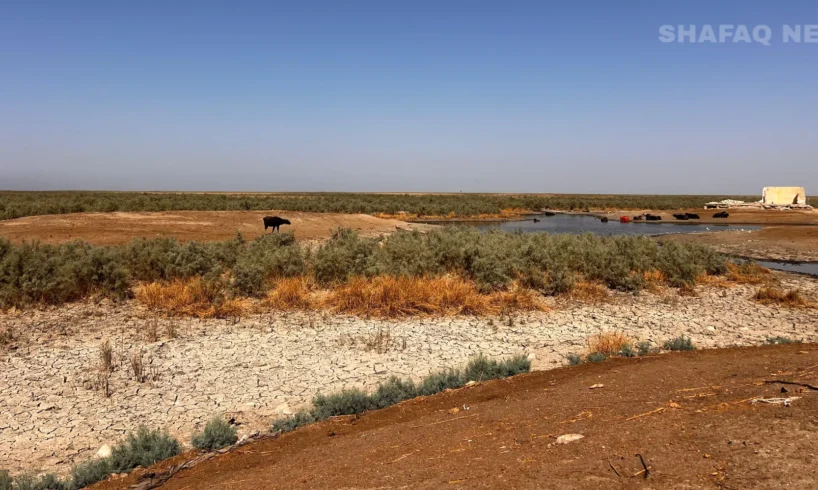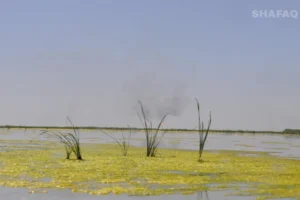
2025-10-06T20:18:58+00:00
font
Enable Reading Mode
A-
A
A+
Shafaq News
In the parched plains of southern
Iraq, the riverbeds are cracking. Once the lifeline of villages and marshlands,
the waters of the Umm al-Tus River have vanished, leaving behind dust, dead
reeds, and silence.
For residents of Abu Khassaf in
Maysan province, life without water has become a daily ordeal. “The river’s
death forced many families to leave,” Kadhim Karim Hassan, a villager who once
lived by fishing and buffalo herding, told Shafaq News. “We now drive for miles
just to bathe or bring clean water.”
Across southern Iraq, rivers and
marshes are collapsing under the combined weight of drought, upstream
restrictions, and decades of mismanagement. Environmental groups warn that if
current trends persist, the region that gave birth to Mesopotamian civilization
could soon become uninhabitable.
The UN Environment Programme (UNEP)
estimates that over 70 percent of Iraq’s southern marshes have dried up since
2021 — a pace it describes as “the fastest ecological collapse in modern Middle
Eastern history.”
Rapid depletion has devastated
ecosystems and disrupted traditional livelihoods, forcing more than 20,000
families to abandon fishing, reed harvesting, and livestock herding.
Environmental activist Ahmed Saleh
Neama told Shafaq that the Umm al-Tus River, which once fed the Huweiza Marsh,
has not seen a drop of water for months. “The pumping stations stopped long
ago,” he explained. “The marshes are cut off and dying.”
In Dhi Qar and Maysan, buffalo
herders report losing entire herds to thirst and disease. “Every drought year,
we lose part of our history,” said Abu al-Hasan al-Musafari, head of the
Gilgamesh Foundation for Heritage and Marshes.
Roots of the Crisis
Experts trace Iraq’s worsening water
crisis to a convergence of political, climatic, and structural factors. Nearly
90 percent of Iraq’s freshwater originates in neighboring Turkiye, where
massive dam projects along the Tigris and Euphrates — including the Ilisu Dam —
have sharply reduced downstream flow.
Despite Ankara’s pledge in June 2025
to release 420 cubic meters per second, Iraqi officials and UN data show that
actual inflows remain far lower.
“The problem isn’t just quantity;
it’s consistency,” said a senior water official in Baghdad. “Unpredictable
releases make it impossible to manage what little we have.”
Meanwhile, rainfall across Iraq has
fallen 30 percent over the past two decades, while temperatures have risen
nearly 2°C above pre-industrial levels — accelerating evaporation and
desertification.
At the local level, unregulated fish
farms, illegal irrigation canals, and excessive planting of water-intensive
crops such as rice and wheat have drained tributaries like Umm al-Tus dry.
Read more: Iraq’s water crisis deepens: Reserves collapse, mismanagement continues.
Ecological and Human Fallout
According to the Food and
Agriculture Organization (FAO), water buffalo populations have fallen by 80
percent since 2018, while migratory birds that once filled the skies over the
southern wetlands no longer return. Rising groundwater salinity has rendered
vast stretches of farmland barren.
For local communities, the disaster
is both environmental and existential. Families who lived for generations among
the reeds now flee northward. Schools in rural areas have closed, and health
officials warn of waterborne diseases spreading from stagnant pools.
A Heritage in Peril
Iraq’s southern wetlands —
recognized by UNESCO in 2016 as a World Heritage Site — once symbolized
ecological rebirth after Saddam Hussein’s campaign to drain them in the 1990s.
Today, those same marshes are again shrinking into dust.
UNESCO has warned that without
sustained inflows and international cooperation, parts of the Huweiza and
Central Marshes could become “permanently lost ecosystems.”
Baghdad says it continues to push
for binding water agreements with upstream countries and to modernize
irrigation systems. But experts caution that time is running out.
“The marshes are dying,” one
resident said. “And with them, a way of life thousands of years old — the last
living trace of ancient Mesopotamia.”
Written and edited by Shafaq News
staff.





